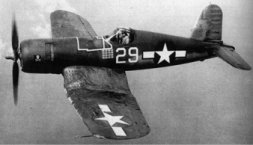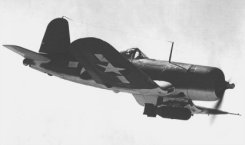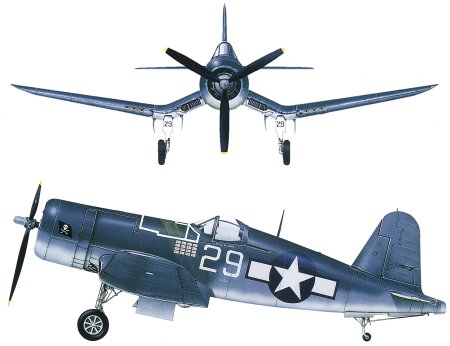
Vought F4U Corsair
Vought's F4U Corsair was one of the finest fighters ever built. At first thought too powerful to fly from carrier decks, the Corsair weaved a path of destruction in the battle after battle during World War II, totally outclassing the much-feared Japanese Zero. With its instantly recognisable gull- wing shape and its great speed and firepower, the Corsair was still coming off the production line in 1953, one of the last of the great piston engined fighters.
The fighter which took shape in designer Rex Beisel's drawing board in 1938 was a monster. The prototype Vought F4U Corsair, flown on 29 May 1940, was the heaviest shipborne fighter built to that time. It was tough, fast and very manoeuvrable but early pilots encountered handling problems at low speeds and the restricted view made carrier landing very tricky. As a result, the first Corsairs in combat were flown with enormous success by land-based Marines.
Modified with a raised seat and bulged canopy, Corsairs were flying from British carriers in 1943 and from US Navy carriers by 1944 and racked up an impressive score of aerial victories against Japan's best fighters. Corsairs using bombs and rockets paved the way for the final battles of Iwo Jima and Okinawa. The Royal Navy also used the Corsair to great effect in the Pacific, attacking Japanese oil refineries and airfields.
Vought's remarkabke fighter also manufactured by Brewster and Goodyear, was still an important component in US naval air power during the Korean War. One Corsair even shot doen a MiG-15 jet fighter.
 |
 |
 |
| Flying in May 1940, the XF4U-1 was the smallest possible airframe mated with the most powerful engine then available. |
From its earliest test flights in 1940, the Corsair showed that it could exceed 650 km/h (400 mph) in a straight line. |
As the Corsair's place as a fighter was taken by jets, the tough Vought warbird was turned into a highly effective ground-attack machine. |
|
Vought F4U Corsair (Technical Specification) |
| Role |
Single-seat, carrier-operable fighter bomber |
| Manufacturer |
Vought |
| Maximum Speed |
671 kmh (417 mph) |
| Maximum Range |
1650 km (1,010 miles) |
| Ceiling |
11,247 meters (37,000 feet) |
Weight
Empty
Maximum Takeoff |
4,074 kg (9,000 lbs)
6,350 kg (14,000 lbs) |
Dimensions
Wingspan
Length
Height
Wing Area |
12.49 meters (41 ft)
10.16 meters (33 ft 5 in)
4.90 meters (15 ft 1 in)
29.17 square meters (314 sq ft) |
| Engines |
One Pratt & Whitney R-2800-8 Double Wasp 18-cylinder radial engine which provides 1492-kW (2,000 hp) |
| Armament |
Six 12.77 mm (0.50 cal) Browning M2 machine-guns with 400 rounds (outboard) and 375 rounds (inboard) per gun
1800 kg (4,000 lbs) of bombs or rockets
|
Photo Gallery
Click here to submit your photo
| Have A Passion For Aircraft? |
Subscribe to our 14 series FREE newsletter
delivered weekly on World War 2 Aircraft factfile... |
| NB:- We hate spam as much as you do, so your email address will NEVER be shared with or sold to anyone else. That's a Guarantee. |
|
|







